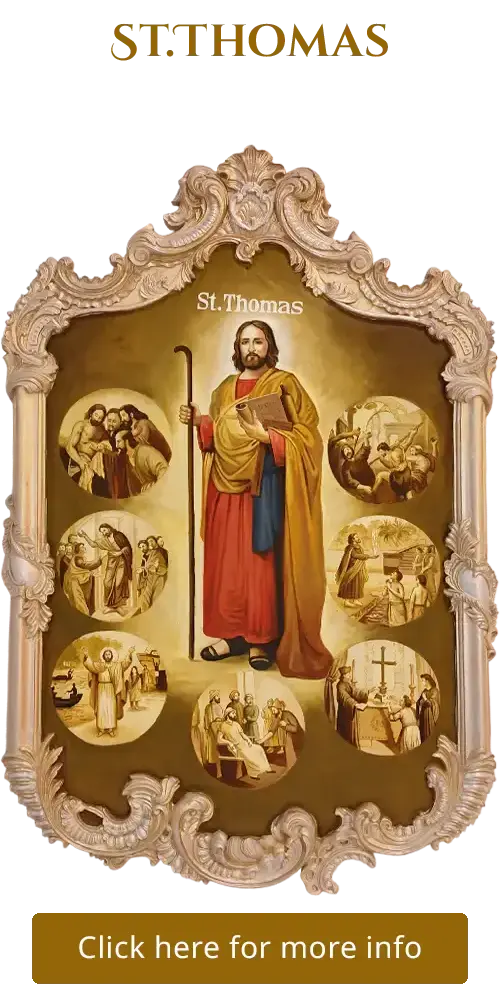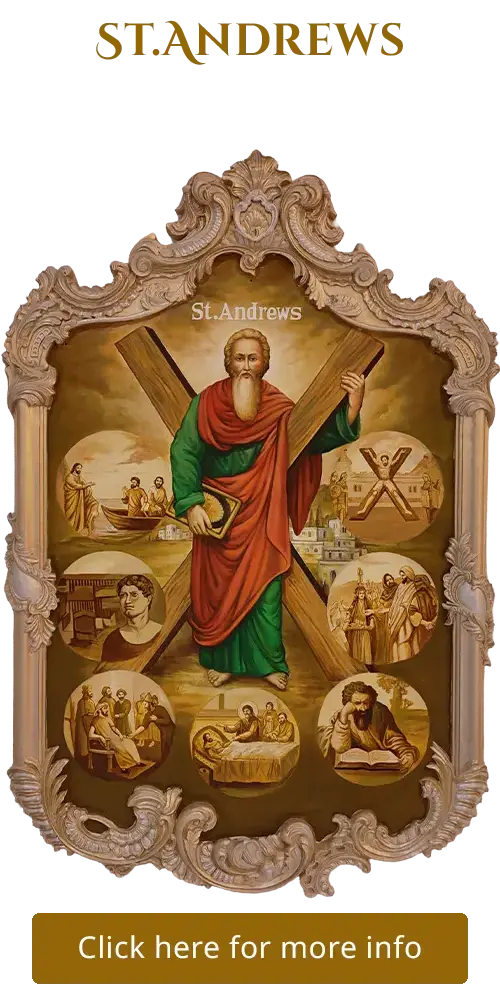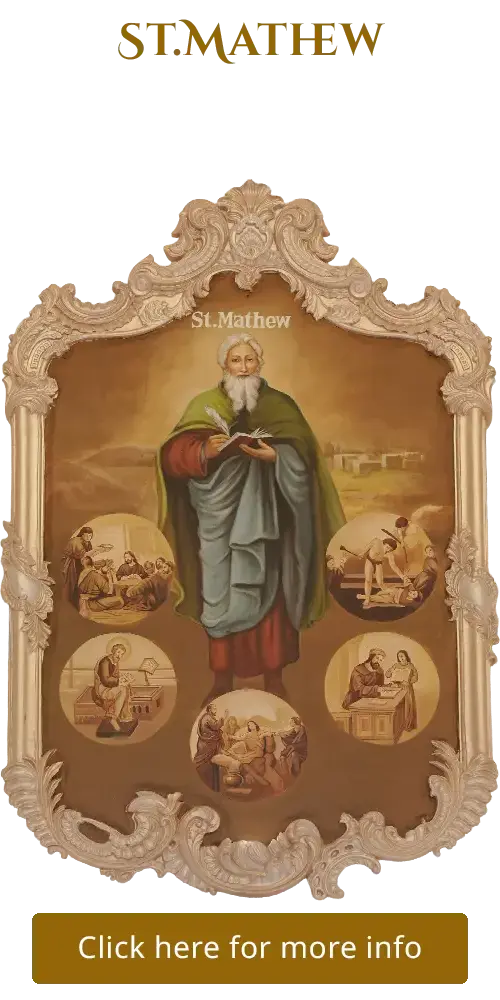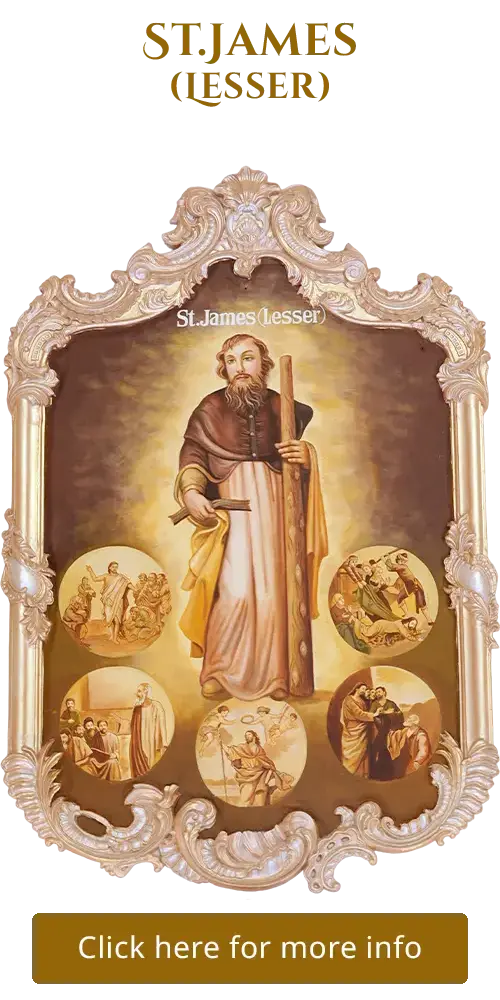St. Andrews
Inside Paintings - North Wall
St. Andrews
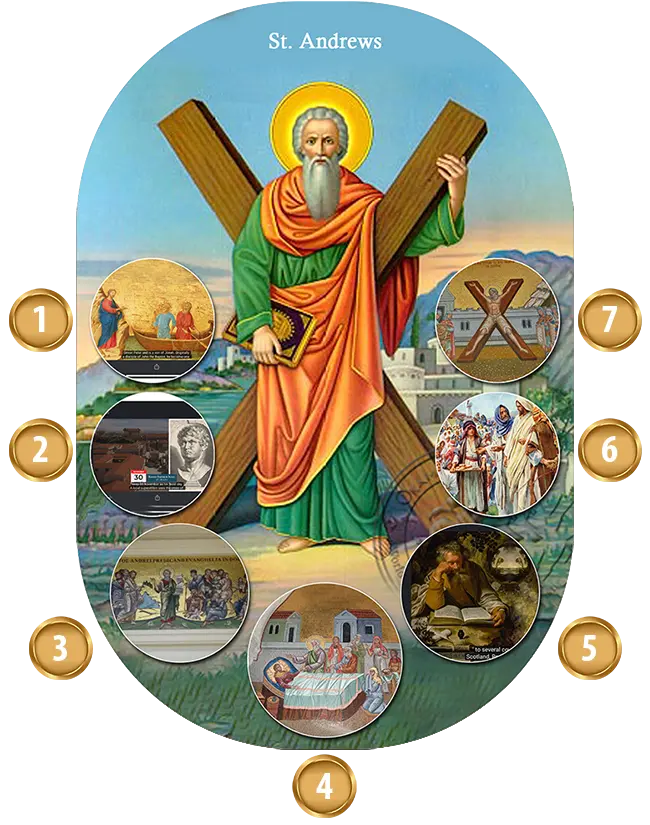


1. Call to Discipleship
Biblical Reference: Matthew 4:18-20, Mark 1:16-20
Description: Jesus begins his ministry to the people by calling disciples, or apostles, those who will help him spread his teachings.
Jesus, while walking by the Sea of Galilee, encounters two fishermen, Simon (Peter) and his brother Andrew, casting their nets. He calls them to follow him, promising to make them “fishers of men.” They immediately leave their nets and follow him.
2. Andrew’s Question at the Mount of Olives
Biblical Reference: Mark 13:1-4
Description: In the Gospel of Mark 13:1-4, as Jesus and His disciples left the temple, Andrew, along with Peter, James, and John, marvelled at the grandeur of the temple’s stones and buildings. Jesus responded with a prophecy, foretelling that not one stone would be left upon another (Mark 13:2). Later, on the Mount of Olives, Andrew and the others privately asked Jesus, “Tell us, when will these things happen? And what will be the sign that they are all about to be fulfilled?” (Mark 13:4).
This moment, often called the Olivet Discourse, reveals Andrew’s seeking heart, longing to understand the mysteries of God’s plan. Jesus’ response (Mark 13:5-37) speaks of signs, trials, and the coming of the Son of Man, urging vigilance and faithfulness. For our church, this scene inspires us to seek God’s truth with humility and to live in readiness for Christ’s return, trusting in His words: “Heaven and earth will pass away, but my words will never pass away” (Mark 13:31).
Andrew’s question reminds us to approach God with awe and curiosity, trusting in His divine wisdom as we await the fulfilment of His promises.
3. St. Andrew Preaching
Historical Reference: Church History 3.1 (4th century) by Eusebius, apocryphal Acts of Andrew
Description: He preached in regions around the Mediterranean and Black Sea, including Scythia and areas along its northern coast. He also traveled through Greece and Asia Minor (modern-day Turkey). He is credited with establishing the see of Byzantium, which later became Constantinople, and installing Stachys as its first bishop. This event is a key part of the history of the Ecumenical Patriarchate of Constantinople.
4. Healing the wife of Roman Governor
Historical Reference: Relics in Patras, Greece, at the Church of St. Andrew
Description: St. Andrew’s ministry in Patras was marked by healings and conversions, including healing Maximilla, the wife of the Roman governor Aegeas, from a serious illness. This healing, along with other miracles and Andrew’s preaching, led many citizens of Patras, including Maximilla and her brother-in-law Stratokles, to convert to Christianity. Aegeas, however, was angered by his wife’s conversion and Andrew’s influence, ultimately leading to Andrew’s crucifixion.
5. St. Andrew the Patron of several countries and cities
Historical Reference: Content from Fr.Rijo
Description: St. Andrew, the Apostle, is frequently depicted in Christian art holding a Gospel Book or a scroll. This portrayal is often linked to his role as one of the first followers of Jesus and his subsequent missionary work.
St. Andrew is the patron saint of several countries and cities, including Barbados, Romania, Russia, Scotland, Ukraine, Sarzana, Pienza and Amalfi in Italy, Penrith in England, Esgueira in Portugal, Luqa in Malta, Parañaque in the Philippines and Patras in Greece. He was also the patron saint of Prussia and of the Order of the Golden Fleece. He is considered the founder and the first bishop of the Church of Byzantium and is consequently the patron saint of the Ecumenical Patriarchate of Constantinople. Thus, Pope Benedict XVI calls him “The Apostle of the Greek world”.
6. The Miracle of the Loaves and Fishes
Historical Reference: John 6:1-14
Description: When Jesus heard that John the Baptist had been killed, he withdrew by boat privately to a solitary place near Bethsaida. The crowds followed Jesus on foot from the towns. When Jesus landed and saw a large crowd, he had compassion on them and healed their sick.
As evening approached, the disciples came to him and said, “This is a remote place, and it’s already getting late. Send the crowds away, so they can go to the villages and buy themselves some food”. Jesus said that they did not need to go away, and therefore the disciples were to give them something to eat. Andrew, points out a young boy with five loaves and two fish, which Jesus asked to be brought to him. Andrew asked, “what is that among so many?”
Jesus directed the people to sit down in groups on the grass. The crowds sat in groups of 50 and there were 100 such groups. Taking the five loaves and the two fish and looking up to heaven, Jesus gave thanks and broke them. Then he gave them to the disciples, and the disciples gave them to the people. They all ate and were satisfied, and the disciples picked up twelve baskets full of broken pieces that were left over. The number of those who ate was about five thousand men, besides women and children.
7.Martyrdom of St. Andrew
Historical Reference: Acts of Andrew (apocryphal text, 2nd century)
Description: Andrew was martyred in Patras, Greece, during the reign of the Roman governor Aegeas. When he was condemned to die, he refused to be crucified on the same kind of cross as Jesus, considering himself unworthy. Instead, he was bound—not nailed—to an X-shaped cross, now known as St. Andrew’s Cross.
But here’s what makes his death so powerful: he didn’t die quickly.
Bound to the cross, Andrew hung there for two full days, preaching to the crowds the entire time. According to tradition, he cried out to God and proclaimed the gospel with every breath until his final one. He turned his death into a pulpit.
Maximilla, wife of the Roman governor Aegeas is said to have received Andrew’s body after his death.


